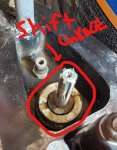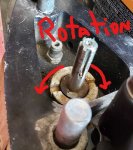First off the vertical DRIVE shaft has a pinion gear on the bottom end that simultaneously connects to F and R gears thus causing them to rotate in opposite directions and do so as long as the crankshaft is rotating. The shifter mechanism uses a sliding "Clutch Dog", mounted on and locked to (the rotation of) the PROP shaft to select which gear will be selected, operated by the cam attached to the splined shifter rod you circled.
In Neutral, the Dog connects the PROP shaft to neither the rear of F gear nor the front of R gear so the prop shaft is free wheeling. To shift gears, the Dog is forced into one or the other of the engagement gears. There is a spring loaded "CAM Follower" (a hollow, round nosed, spring loaded, bullet) that is moved back and forth along the PROP shaft, executing the F or R gear engagement as a function of the position of the shifter CAM (a flat plate with a splined hole for control and 3 dug-out areas different distances from the pivot point for controlling the CAM follower mentioned above); rotation is horizontal as you mentioned.
F is the first detent in the cam and is the closest to the splined shaft (pivot point) and puts the least amount of pressure on the "cam follower" allowing the spring to relax and allow the clutch dog to lock into the rear of the F gear locking it to the PROP shaft. This is evidenced by CCW rotation of the propeller, looking from the rear and watching the drive shaft rotate. CW rotation in F is an over run clutch which allows the prop to turn with out the drive shaft turning with a clicking noise while being rotated and a slight in-out movement of the prop shaft to the LU housing.
Rotating that shifter shaft to the center position is N and the cam detent for that is slightly farther away from the pivot point causing more pressure to be applied to the spring loaded CAM follower causing the "Clutch Dog" to move into it's central position along the PROP shaft and in not touching either F or R gears the PROP shaft is free to free wheel.
Continuing to rotate the shifter shaft, you rotate the cam to the farthest position from the pivot point putting maximum pressure on the CAM follower spring and forcing the Clutch Dog into the front of R gear thus connecting it to the PROP shaft and Reverse operation. Unlike F gear, the connection between the Clutch Dog and R gear is cogs and sockets with vertical sides. SLIGHT pressure is applied to the shifter shaft as the prop is rotated. Engagement will come when a cog and socket line up and then the shifter shaft can continue it's rotation to full engagement......any time the engine isn't running, the prop must be rotated by hand while attempting to engage R gear to prevent damage to the shifting linkages....per the manual.
Once in R gear, rotating the prop in either direction will cause movement of the DRIVE shaft in a corresponding direction with no slop.
Does that help? Want more, ask.





















